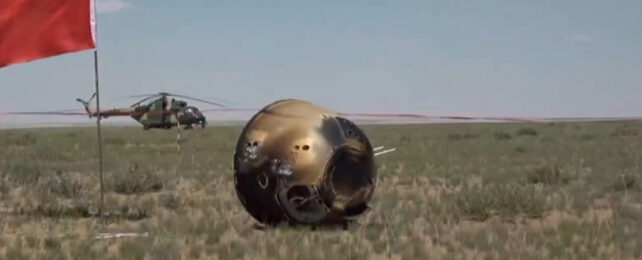Three weeks after it lifted off from the far side of the moon, China's Chang'e-6 spacecraft dropped off a capsule containing first-of-its-kind lunar samples for retrieval from the plains of Inner Mongolia.
The gumdrop-shaped sample return capsule floated down to the ground on the end of a parachute, with the descent tracked on live television. After today's touchdown, at 2:07 p.m. local time (0607 GMT), members of the mission's recovery team checked the capsule and unfurled a Chinese flag nearby.
Chang'e-6, which was launched in early May, is the first robotic mission to land and lift off again from the Moon's far side – the side that always faces away from Earth. It's also the first mission to bring dirt and rocks from the far side back to Earth.
"The Chang'e-6 lunar exploration mission achieved complete success," Zhang Kejian, director of the China National Space Administration, said from mission control. Chinese President Xi Jinping extended congratulations to the mission team, the state-run Xinhua news service reported.
Chang'e-6 followed a flight plan similar to the one used for Chang'e-5, a mission that brought back samples from the moon's Earth-facing side in 2020. After entering lunar orbit, the spacecraft sent a lander down to the Moon's South Pole-Aitken Basin region.
The lander used an onboard drill and robotic arm to collect and store samples on its ascent stage. It also gathered data about its surroundings with a radon detector, a negative-ion detector and a mini-rover. Data and telemetry were relayed between Chang'e-6 and Earth via China's Queqiao-2 satellite.
On June 4, Chang'e-6's ascent stage lifted off for a rendezvous with the orbiting spacecraft. The samples were transferred to a re-entry capsule, and the spacecraft left lunar orbit several days ago for the trip back to Earth.
The re-entry capsule was released as the spacecraft sped about 5,000 kilometers (3,100 miles) over the South Atlantic Ocean, CNSA said in a mission update.
After an initial round of processing at the landing site in China's Inner Mongolia region, the capsule is due to be airlifted to Beijing, where the mission's precious cargo will be removed for distribution to researchers.
The samples are expected to include volcanic rock and other materials that could shed fresh light on the Moon's origins and compositional differences between the near side and the far side. Scientists may also learn more about resources in the Moon's south polar region. That region is of high interest because it's thought to harbor deposits of water ice that could be used to support future lunar settlements.
NASA is targeting the south polar region for a series of robotic missions – leading up to a crewed landing during the Artemis 3 mission, which is currently scheduled for 2026. China has its own lunar ambitions, including plans for sending astronauts to the lunar surface by 2030.
This article was originally published by Universe Today. Read the original article.
